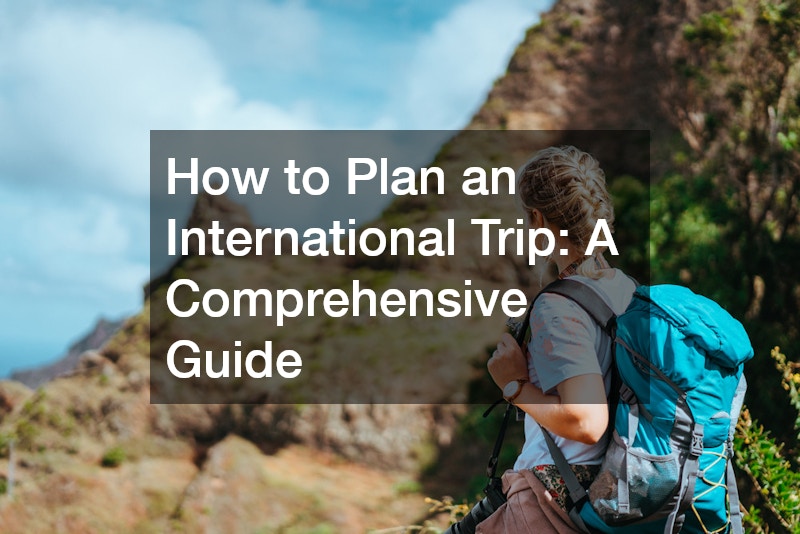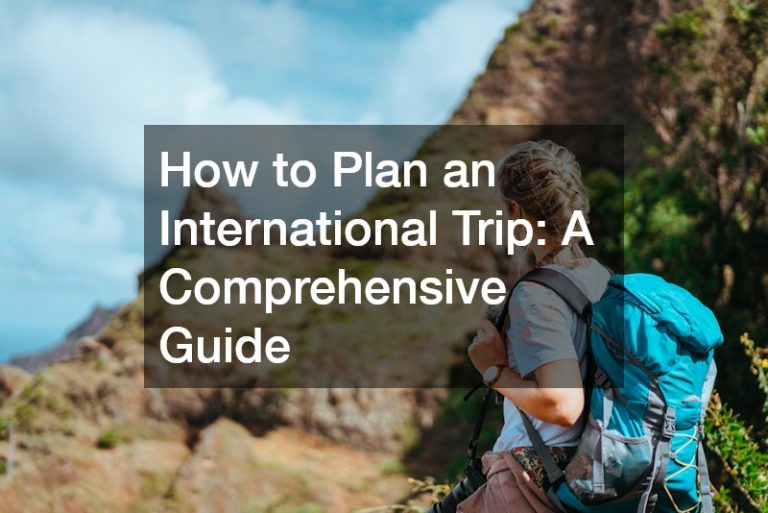Wondering how to plan an international trip that you’ve always wanted to take? It can be an exhilarating yet daunting adventure. With endless destinations and cultures awaiting your discovery, having a well-structured plan is essential to make the most out of your journey. Proper planning not only helps you stay organized but also allows you to maximize your time, budget, and experiences while avoiding unnecessary stress. From choosing the perfect destination to understanding visa requirements and travel insurance, every detail plays a crucial role. In this comprehensive guide, we will navigate through the various stages of planning your trip, from scheduling to enjoying local activities and cuisine, ensuring that each aspect of your travel experience is catered to with meticulous attention. Along the way, we’ll explore invaluable insights and resources to enhance your experience. Whether you’re a first-time traveler or a seasoned explorer, careful preparation will set the foundation for a truly unforgettable adventure. Let’s embark on the adventure of planning an international trip together.
1. Scheduling Your Vacation

When considering how to Plan an international trip, scheduling your vacation is the foundational step. It’s important to consider the timing of school breaks if you’re traveling with children, as international schools often have different holiday schedules. Aligning your vacation with these breaks can ensure a stress-free experience without compromising academic responsibilities. Furthermore, researching the peak and off-peak travel seasons of your chosen destination not only allows for a more cost-effective journey but also provides insights into local cultural events and festivals to be a part of.
When planning your schedule, don’t forget to factor in the necessary buffer time for travel delays and potential changes. Flexibility is key in ensuring a smooth transition from one leg of your journey to another. Additionally, work with long distance movers to ensure your home affairs are in order during your absence. Having a firm grasp on logistics will give you peace of mind as you venture further from home.
Finally, consider the implications of time zone changes and the need for acclimatization upon arrival. Jet lag can make the initial days of your trip less enjoyable, so plan for some downtime if necessary. Utilizing resources can help streamline this process, offering tailored scheduling advice specific to your destination. This attention to detail ensures that your vacation starts on the right note.
2. What Sights Do You Want to See?
When it comes to choosing what sights to see during your international trip, start by researching iconic landmarks and off-the-beaten-path attractions. This is important when you are thinking about how to plan an international trip. Collaborate with architectural designers to understand the historical significance of buildings you plan to visit. Knowing the story behind these structures adds depth to your experience, allowing you to appreciate the intricate details of design and heritage.
Take into consideration the location of these attractions and plan your itinerary accordingly. Grouping nearby sights can save travel time and minimize logistical headaches. Be sure to consider opening hours and any cultural practices that might necessitate an adapted schedule, such as siesta times common in certain countries.
Don’t limit yourself to just popular tourist destinations; explore lesser-known neighborhoods and interact with locals to gain a more authentic understanding of the culture. Often, these spontaneous encounters yield more memorable experiences than planned activities. Understanding and connecting with the spirit of a place also enriches your journey, making it more than just a checklist of places seen but an immersive cultural adventure.
3. Packing Accordingly
Packing efficiently is an important skill to master when you are learning how to plan an international trip. It is an art that requires careful planning and an understanding of your destination’s climate and cultural norms. Consulting with a storage company can provide you with organizational tips and packing solutions to maximize space and accessibility. Consider creating a packing checklist that includes essential items tailored to both anticipated needs and unexpected scenarios.
Layering clothing is a versatile method that caters to changing weather conditions, and selecting a neutral color palette can simplify outfit coordination. Don’t forget to include necessary travel documents, electronic chargers, and any medications in easily accessible compartments in your hand luggage. This minimizes stress and ensures that critical items are always within reach.
Being mindful of luggage weight restrictions is also crucial. Weigh your bags before heading to the airport to avoid any surprises during check-in. With the right preparation and planning as a guiding resource, you can pack smartly and ensure all essentials are accounted for, leaving more room for souvenirs from your journey.
4. Consider the Purpose of Your Trip

Effective planning can transform your international trip from a mere vacation into an unforgettable experience. Start by defining the purpose of your trip—whether it be adventure, relaxation, cultural immersion, or a combination thereof. Numerous travel planning tools and resources are available to help organize your thoughts and ideas into a comprehensive itinerary. You can’t forget this when learning how to plan an international trip.
Consulting with long distance movers can facilitate logistics of extended travels, such as securing your home and arranging for pet care if necessary. Their expertise ensures that your personal affairs are managed, leaving you free to focus on your voyage. A well-thought-out itinerary provides a balance between structured activities and leisure time.
Incorporate buffer days into your schedule, allowing for additional exploration or rest as needed. This flexibility is essential in adapting to the unforeseen—be it weather changes or unplanned detours. Planning every detail with intent allows you to embrace spontaneity without sacrificing security, allowing you to fully immerse yourself in the travel experience.
5. What Activities Do You Want to Do?
Something very important to consider when thinking about how to plan an international trip is the activities you choose. They will define your experience and what you take away from it. Engage with local tour companies and jet ski dealers to explore unique recreational activities specific to your destination. Whether it’s sailing on crystal-clear waters or hiking scenic mountain trails, these activities offer an incomparable thrill.
In each destination, there lies the opportunity to learn new skills or indulge in untried experiences. Consider workshops, classes, or specialized excursions that provide cultural insight and hands-on involvement. The knowledge and experiences you gain will be lasting souvenirs that you carry with you beyond the trip’s conclusion.
Balance active and leisurely pursuits within your schedule to cater to all interests and fitness levels. Consider organizing days around AM and PM activities, leaving room for relaxation and reflection in between. Aligning your activities with local events further enriches your itinerary, providing an extraordinary tapestry of experiences.
6. What Food Do You Want to Eat?
Culinary exploration is an important area to include when learning how to plan an international trip. It can often be one of the most memorable aspects of international travel. Research local catering companies to find authentic eateries, dining experiences, and markets that showcase the flavors of the region. Engage with local chefs and vendors to understand the heritage and ingredients that define the cuisine.
Venture beyond renowned spots to hidden gems recommended by locals—these are often where you find the most authentic dishes. Engaging with locals about food also reveals cultural practices, bringing about an appreciation for mealtime rituals and traditions that differ from the norm back home.
Document your culinary journey with photographs and tasting notes. While indulging, be mindful of food safety and dietary restrictions to ensure a pleasurable dining experience throughout your travels. Utilizing this as guidance can assist in curating a delectable adventure that delights all the senses.
7. Should I Use a Travel Company?

When learning how to plan an international trip it may be crucial for you to determine whether or not you should take advantage of a travel company. Deciding whether to use a travel company hinges on your personal preferences, travel experience, and the complexity of your itinerary. For destinations with challenging logistics or when crafting multifaceted trips like Alaska excursions, a travel company can provide specialized expertise and resources.
Travel companies offer convenience and peace of mind, handling everything from bookings and accommodations to guided tours and transportation. This allows you to focus on creating memories and enjoying your journey without being bogged down by administrative details.
However, independently planning your trip permits greater flexibility and personalization, catering more closely to your unique interests and budget. Consider using a blend of both approaches, using travel company services for specific segments while self-planning others. This hybrid methodology can maximize both convenience and customization.
8. Travel Necessities
Travel necessities encompass all the supplementary aspects required for a seamless and enjoyable journey. From porta potty rentals for remote locations to insurance and travel visas, preparation mitigates risks and potential complications. Each detail addressed enhances the efficiency and fluidity of your trips.
Investing in quality luggage, travel adapters, and portable chargers ensures you remain connected and organized. The inclusion of car audio systems can also enrich journeys that involve long road trips, providing entertainment and navigation with ease. These practical measures enhance the comfort and safety of your travels.
Don’t overlook the significance of having a comprehensive first aid kit and emergency contact information readily available. These considerations ensure preparedness in case of illness or unexpected situations, allowing you to confidently navigate foreign environments. Employing how to plan an international trip keeps these vital aspects accounted for, smoothing the way for enjoyable adventures.
9. Staying Connected
Staying connected during your international trip ensures that communication with loved ones and work obligations is uninterrupted. Investments in mobile data plans, international SIM cards, or portable Wi-Fi devices facilitate seamless connectivity. Depending on your needs, different solutions may offer more economical or convenient access.
Embracing technology without letting it overshadow your travel experience is critical. Devices like smartphones and tablets provide both a means to capture memories and a tool to discover local attractions. Look for apps that offer offline functionality for maps and translation to remain prepared in areas with limited service.
While traveling, don’t neglect the importance of unplugging and immersing fully in the present moment. Balance connectivity with mindfulness, allowing moments to be cherished amid a harmonious interplay between the two. Integrating technology empowers you with the strategies and solutions to remain connected without compromising the authenticity of your journey.
10. Maintaining Your Health

Your health is vital to enjoying every aspect of learning how to plan an international trip. Investigate water sanitizing options for regions where water quality may be a concern, ensuring hydration is safe and adequate. Research any vaccinations or preventative measures required well in advance to meet health standards.
Be proactive in managing health concerns by carrying necessary medications and adhering to a well-balanced diet and exercise routine. Scheduling routine check-ups before departure can prevent any unforeseen issues. These precautions, in tandem with the security provided by whom it may concern, ensure a healthier and more reassuring travel experience.
Remain adaptable in the face of minor illnesses or discomfort, as stress only exacerbates such situations. Adapt your itinerary if rest is needed, knowing that flexibility is a hallmark of successful travel. By prioritizing your well-being, you are better equipped to relish every exploration, encounter, and escapade on your journey.
In conclusion, learning how to plan an international trip is an intricate yet rewarding journey. Each step, from scheduling your vacation to embracing the local culture, plays a pivotal role in creating memories that last a lifetime. By systematically approaching each aspect and integrating essential resources, your adventures will be smooth and fulfilled. Careful research, budgeting, and adaptability ensure that unexpected challenges become part of the experience rather than obstacles. Whether you’re savoring new cuisines, exploring historical landmarks, or connecting with locals, every journey broadens your perspective and deepens your appreciation for the world’s diversity. As you embark on your international travels, may each plane ticket, packed suitcase, and a new stamp in your passport become a vessel of vibrant stories and profound connections. Travel not just to see, but to learn, grow, and be inspired by the beauty of different cultures. Bon voyage!









